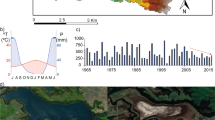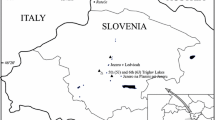Abstract
Sediment cores from Sargent Mountain Pond, Maine, USA and Plešné Lake, southwestern Czech Republic, record the entire post-glacial terrestrial vegetation, lake algal communities, and chemical dynamics of the watershed and lake from 16,600 and 14,600 Cal Yr BP, respectively, to the present. Both watersheds are underlain by granite, and overlain by till. Total rare earth element (REE) concentrations and fluxes to the sediment declined from deglaciation until forest developed slightly prior to the Younger Dryas (YD) (12,600–11,600 Cal Yr BP) at Sargent Mountain Pond, and immediately after the YD at Plešné Lake, peaked in value just after the YD, and then declined to the present. Before the YD, REE concentrations were dominated by detrital, soluble apatite [Ca5(PO4)3(OH)]. Weathering of apatite contributed the phosphorus (P) sequestered as NaOH-extractable P in the lake sediment. After the YD, REE concentrations and fluxes behave coherently with NaOH-extractable aluminum (Al) and P after forestation in each catchment. Concentrations of extractable REEs, P, and Al peak after the YD and decline coherently to the present. We hypothesize that as climate ameliorated after glaciation, afforestation occurred and organic-rich forest soils developed. These soils produced higher concentrations of dissolved organic carbon (DOC) in soil water and runoff. Concurrently, the weathering of apatite released PO4 and Ca to runoff, raising pH to ~8. The soil DOC complexed with and mobilized Al and REEs, which were transported to the lakes in runoff. There, photo-oxidation of the Al–DOC and REE–DOC complexes caused release of ionic, inorganic Al and REEs, precipitation of Al(OH)3 in the higher-pH environment, adsorption of REEs and PO4 by the Al(OH)3, and irreversible sedimentation. REE concentrations and fluxes declined from the YD to the present because the apatite was progressively depleted in the soil by weathering, while REEs were increasingly retained by secondary Al(OH)3 [and Fe(OH)3 to a lesser degree] in the soil. The adsorption ability of soil and water-column Al(OH)3 for P increased, but for REEs likely declined, as the watershed soils developed and acidified. This natural process was further magnified by atmospheric acidification, as indicated by changes in diatom assemblages.







Similar content being viewed by others
References
Aubert D, Stille S, Probst A (2001) REE fractionation during granite weathering and removal by waters and suspended loads: Sr and Nd isotopic evidence. Geochim Cosmochim Acta 65:387–406
Banfield JF, Eggleton RA (1989) Apatite replacement and rare earth mobilization, fractionation, and fixation during weathering. Clay Clay Miner 37:113–127
Boyle JF, Chiverrell RC, Norton SA, Plater AJ (2013) A leaky model of long-term soil phosphorus dynamics. Glob Biogeochem Cycles. doi:10.1002/gbc.20039
Calvaruso C, Turpault MP, Frey-Klett P, Uroz S, Pierret MC, Kies A (2013) Effect of Scots pine roots associated or not with Burkholderia glathei PML1(12) on apatite dissolution rate. Geochim Cosmochim Acta 106:287–306
Chaïrat C, Schott J, Oelkers EH, Lartigue JE, Harouiya N (2007) Kinetics and mechanism of natural fluoroapatite dissolution at 25°C and pH from 3 to 12. Geochim Cosmochim Acta 71:5901–5912
Davranche M, Pourret O, Gruau G, Dia A, Jin D, Gaertner D (2008) Competitive binding of REE to humic acid and manganese oxide: impact of reaction kinetics on development of cerium anomaly and REE adsorption. Chem Geol 247:154–170
Ding R, Wood SA (2002) The aqueous geochemistry of the rare earth elements and yttrium. Part X. Potentiometric determination of stability constants of acetate complexes of La3+, Nd3+, Gd3+ and Yb3+ at 25–70 °C and 1 bar. In: Helmann R, Wood SA (eds) Water–rock interactions, ore deposits, and environmental geochemistry: a tribute to David A. Crerar. The Geochemical Society, Special Publication No 7, pp 209–227
Environmental Protection Agency (1994) Method 3051A, microwave assisted acid digestion of sediments, sludges, soils and oils. US EPA, Washington
Gilman RA, Chapman CA, Lowell TV, Borns HW Jr (1988) The geology of Mount Desert Island, vol 38. Maine Geological Survey Bulletin, Maine
Guidry MW, MacKenzie FT (2000) Apatite weathering and the Phanerozoic phosphorus cycle. Geology 28:631–634
Jankovská V (2006) Late Glacial and Holocene history of Plešne Lake and its surrounding landscape based on pollen and palaeoalgological analyses. Biol Brat 61(Suppl 20):S371–S385
Johannesson KH, Tang J, Daniels JM, Bounds WJ, Burdige DJ (2004) Rare earth element concentrations and speciation in organic-rich blackwaters of the Great Dismal Swamp, Virginia, USA. Chem Geol 209:271–294
Kimball KD, Jagels R, Gordon GA, Weathers KC, Carlisle J (1988) Differences between New England coastal fog and mountain cloud water chemistry. Water Air Soil Pollut 39:383–393
Köhler S, Harouiya N, Chairat C, Oelkers EH (2005) Experimental studies of REE fractionation during water–mineral interactions: REE release rates during apatite dissolution from pH 2.8 to 9.2. Chem Geol 222:168–182
Kopáček J, Klementová Š, Norton SA (2005) Photochemical production of ionic and particulate aluminum and iron in lakes. Environ Sci Technol 39:3656–3662
Kopáček J, Marešová M, Hejzlar J, Norton SA (2007) Natural inactivation of phosphorus by aluminum in pre-industrial lake sediments. Limnol Oceanogr 52:1147–1155
Lee JH, Bryne RH (1993) Complexation of trivalent rare earth elements (Ce, Eu, Gd, Tb, Yb) by carbonate ions. Geochim Cosmochim Acta 57:295–302
Leybourne MI, Johannesson KH (2008) Rare earth elements (REE) and yttrium in stream waters stream sediment, and Fe–Mn oxyhydroxides: fractionation, speciation, and controls over REE+Y patters in the surface environment. Geochim Cosmochim Acta 72:5962–5983
Liu X, Byrne RH (1997) Rare earth and ytrrium phosphate solubilities in aqueous solution. Geochim Cosmochim Acta 61:1625–1633
Long KR, Van Gosen BS, Foley NK, Cordier D (2010) The principal rare earth elements deposits of the United States. USGS Scientific Investigations Report 5220
Majer V, Cosby BJ, Kopáček J, Veselý J (2003) Modelling reversibility of central European mountain lakes from acidification: Part I—the Bohemian forest. Hydrol Earth System Sci 7:494–509
Middleburg JJ, van der Weijden CH, Woittiez JR (1988) Chemical processes affecting the mobility of major, minor, and trace elements during weathering of granitic rocks. Chem Geol 68:253–273
National Atmospheric Deposition Program (2014). www.nadp.sws.uiuc.edu
Ndjigui P, Bilong P, Bitom D (2009) Negative cerium anomalies in the saprolite zone of serpentinite lateritic profiles in the Lomié ultramafic complex, South–East Cameroon. J Afr Earth Sci 53:59–69
Nesbitt HW, Markovics G (1997) Weathering of granodiorite crust, long-term storage of elements in weathering profiles and petrogenesis of siliciclastic sediment. Geochim Cosmochim Acta 61:1653–1670
Norton SA, Perry RH, Saros J, Jacobson GL Jr, Fernandez IJ, Kopáček J, Wilson TA, SanClements M (2011) The controls on phosphorus availability in a boreal lake ecosystem since deglaciation. J Paleolimnol 46:107–122
Och LM, Müller B, Wichser A, Ulrich A, Vologina EG, Sturm M (2014) Rare earth elementsin the sediments of Lake Baikal. Chem Geol 376:61–75
Ohta A, Kawabe I (2001) REE(III) adsorption onto Mn dioxide (δ-MnO2) and Fe oxyhydroxide: Ce(III) oxidation by δ-MnO2. Geochim Cosmochim Acta 65:695–703
Panahi A, Young GM, Rainbird RH (2000) Behavior of major and trace elements (including REE) during Paleoproterozoic pedogenesis and diagenetic alteration of an Archean granite near Ville Marie, Québec, Canada. Geochim Cosmochim Acta 64:2199–2220
Perry RH (2009) Post glacial chemical weathering and landscape development at Sargent Mountain Pond, Maine, USA: a multiscale investigation. Unpublished MSc thesis, University of Maine
Pierret MC, Clauer N, Bosch D, Blanc G (2010) Formation of metal-rich sediments in the Thetis Deep (Red Sea) in the absence of brines: implications for the genetic model. J Geochem Explor 104:12–26
Pierret MC, Chabaux F, Leroy S, Causse C (2012) Geochemical, isotopic, mineralogical and palynological variations in the sediment of the Caspian Sea: a record of Late Quaternary continental weathering. Quat Sci Rev 51:40–55
Pierret MC, Stille P, Prunier J, Viville D, Chabaux F (2014) Chemical and U–Sr isotopic variations in stream and source waters of the Strengbach watershed (Vosges mountains, France). Hydrol Earth Syst Sci 18:3969–3985
Poitrasson F, Oelkers E, Schott J, Montel J-M (2004) Experimental determination of synthetic NdPO4 monazite end-member solubility in water from 21°C to 300°C: implications for rare earth element mobility in crustal fluids. Geochim Cosmochim Acta 68:2207–2221
Porcal P, Amirbahman A, Kopáček J, Novák F, Norton SA (2009) Photochemical release of humic and fulvic acid-bound metals from simulated soil and streamwater. J Environ Mon 11:1064–1071
Pourret O, Davranche M, Gruau G, Dia A (2007) Rare earth elements complexation with humic acid. Chem Geol 243:128–141
Pražáková M, Veselý J, Fott J, Majer V, Kopáček J (2006) The long-term succession of cladoceran fauna and palaeoclimate forcing: a 14,600-year record from Plešné Lake, the Bohemian forest. Biol Brat 61(Suppl 20):S387–S399
Psenner R, Boström B, Dinka M, Petterson K, Pucsko R, Sager M (1988) Fractionation of phosphorus in suspended matter and sediment. Arch Hydrobiol Beih Ergebn Limnol 30:98–103
Roy SJ, Norton SA, Kahl JS (1999) Phosphorus dynamics at Bear Brooks, Maine USA. Environ Mon Assess 55:133–147
SanClements MD, Fernandez IJ, Norton SA (2009) Soil and sediment phosphorus fractions in a forested watershed at Acadia National Park, ME, USA. For Ecol Manag 258:2318–2325
Stille P, Steinmann M, Pierret MC, Gauthier-Lafaye F, Chabaux F, Viville D, Pourcelot L, Matera V, Aouad G, Aubert D (2006) The impact of vegetation on REE fractionation in stream waters of a small forested catchment (the Strengbach case). Geochim Cosmochim Acta 70:3217–3230
Stuiver M, Reimer PJ (1993) Extended 14C data base and revised CALIB 3.0 14C age calibration program. Radiocarbon 35:215–230
Voicu G, Bardoux M (2002) Geochemical behaviour under tropical weathering of the baramamazaruni greenstone belt at Omai gold mine, Guina Shield. Appl Geochem 17:321–336
Wright HE Jr (1991) Coring tips. J Paleolimnol 6:37–49
Yan XP, Kerrich R, Hendrey MJ (1999) Sequential leachates of multiple grain size fractions from a clay-rich till, Saskatchewan, Canada: implications for controls on the rare earth element geochemistry of pore waters in an aquitard. Chem Geol 158:53–79
Yusoff ZM, Ngwenya BT, Parsons I (2013) Mobility and fractionation of REEs during deep weathering of geochemically contrasting granites in a tropical setting, Malaysia. Chem Geol 349–350:71–86
Acknowledgments
Access to Sargent Mountain Pond (SMP) was supported by the staff of Acadia National Park. We thank George L. Jacobson for leading the coring of SMP. Coring, 14C dating, and chemical analyses for the core were supported by US National Science Foundation Grant DEB-0415348 (Norton et al.) and by the University of Strasbourg/CNRS while Pierret was on sabbatical leave at the University of Maine, supported by a Fulbright Fellowship for 2010–2011. REE analysis was supported by the Climate Change Institute, University of Maine and by the LHYGES, University of Strasbourg (thanks to René Boutin for the ICP-MS analyses). Andrea Nurse (Climate Change Institute, University of Maine) isolated samples for 14C analysis, and supervised the sub-sampling of the SMP core. We thank R. Schmidt from the Institute for Limnology, Mondsee, Austria for sampling of the Plešné Lake sediment. Dating and determination of Ti concentrations in this core were supervised by Josef Veselý (†2006) from the Czech Geological Survey. We are grateful to John Boyle (University of Liverpool) and an anonymous reviewer for very constructive input, enabling us to substantially improve the manuscript.
Author information
Authors and Affiliations
Corresponding author
Electronic supplementary material
Below is the link to the electronic supplementary material.
Rights and permissions
About this article
Cite this article
Norton, S.A., Pierret, MC., Kopáček, J. et al. Long-term dynamics of watershed leaching and lake sediment sequestration of rare earth elements following deglaciation of two mountain watersheds. J Paleolimnol 55, 209–222 (2016). https://doi.org/10.1007/s10933-015-9872-0
Received:
Accepted:
Published:
Issue Date:
DOI: https://doi.org/10.1007/s10933-015-9872-0




